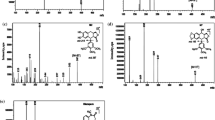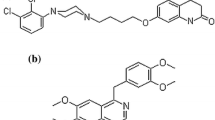Abstract
A sensitive and selective method to quantify budesonide in dog plasma samples was developed and fully validated. Liquid–liquid extraction was followed by solid-phase extraction and liquid chromatography–tandem mass spectrometry with electrospray ionization. After reconstitution of the analytes in the mobile phase, samples were analysed by reversed-phase liquid chromatography with isocratic elution. d8-Budesonide was used as an internal standard, and characteristic transitions of d8-budesonide and budesonide were used for quantification. The method was validated with respect to selectivity, specificity, linearity, recovery, repeatability, reproducibility and limits of detection and quantification. The validated method was successfully applied to monitor the plasma levels of budesonide in dogs exposed to clinical doses of inhaled and intravenous drug.



Similar content being viewed by others
References
Hvizdos KM, Jarvis B (2000) Budesonide inhalation suspension: a review of its inflammatory respiratory disorders. Drugs 60(5):1141–1178
Li YN, Tattam B, Brown KF, Seale JP (2001) Quantification of epimeric budesonide and fluticasone propionate in human plasma by liquid chromatography-atmospheric pressure chemical ionization tandem mass spectrometry. J Chromatogr B 761:177–185
Kronkvist K, Gustavsson M, Wendel A-K, Jaegfeldt H (1998) Automated sample preparation for the determination of budesonide in plasma samples by liquid chromatography and tandem mass spectrometry. J Chromatogr A 823:401–409
Deventer K, Mikulcikova P, Van Hoecke H, Van Eenoo P, Delbeke FT (2006) Detection of budesonide in human urine after inhalation by liquid chromatography-mass spectrometry. J Pharm Biomed Anal 42:474–479
Leung GNW, Chung EW, Ho ENM, Kwok WH, Leung DKK, Tang FPW, Wan TSM, Yu NH (2005) High-throughput screening of corticosteroids and basic drugs in horse urine by liquid chromatography-tandem mass spectrometry. J Chromatogr B 825:47–56
Wang Y, Tang Y, Moellmann H, Hochhaus G (2003) Simultaneous quantification of budesonide and its two metabolites, 6β-hydroxybudesonide and 16β-hydroxyprednisolone, in human plasma by liquid chromatography negative electrosparay ionization tandem mass spectrometry. Biomed Chromatogr 17:158–164
Luo Y, Uboh CE, Soma LR, Guan FY, Rudy JA, Tsang DS (2005) Simultaneous analysis of twenty-one glucocorticoids in equine plasma by liquid chromatography/tandem mass spectrometry. Rapid Commun Mass Spectrom 19:1245–1256
Borges NCC, Astigarraga RB, Sverdloff CE, Borges BC, Paiva TR, Galvinas PR, Moreno RA (2011) Budesonide quantification by HPLC coupled to atmospheric pressure photoionization (APPI) tandem mass spectrometry. J Chromatogr B 879:236–242
Gupta M, Bharbava HN (2006) Development and validation of a high-performance liquid chromatographic method for the analysis of budesonide. J Pharm Biomed Anal 40:423–428
Streel B, Cahay B, Klinkenberg R (2009) Using total error concept for the validation of liquid chromatography-tandem mass spectrometry method for the determination of budesonide epimers in human plasma. J Chromatogr B 877:2290–2300
Fält A, Bengtsson T, Kennedy B-M, Gyllenberg A, Lindberg B, Thorsson L, Strändgarden K (2007) Exposure of infants to budesonide through breast milk of asthmatic mothers. J Allergy Clin Immunol 120:798–802
Hou S, Hindle M, Byron PR (2005) Chromatographic and mass spectral characterization of budesonide and a series of structurally related corticosteroids using LC-MS. J Pharm Biomed Anal 39:196–205
van Trjp JMP, Roos AH (1991) Model for the calculation of calibration curves. RIKILT Report 91.02
Li YN, Tattam B, Brown KF, Seale JP (1996) Determination of epimers 22R and 22S of budesonide in human plasma by high-performance liquid chromatography-armospheric pressure chemical ionization mass spectrometry. J Chromatogr B 683:259–268
Wikby A, Thaen A, Oresten G (1978) Separation of epimers of budesonide and related corticosteroids by high-performance liquid chromatography: a comparison between straight- and reversed-phase systems. J Chromatogr A 157:65–74
Hou S, HindleM BPR (2001) A stability-indicating HPLC assay method for budesonide. J Pharm Biomed Anal 24:371–380
Acknowledgement
Ms. Merja Orpana is thanked for her excellent technical skills in MS analysis.
Author information
Authors and Affiliations
Corresponding author
Rights and permissions
About this article
Cite this article
Berg, S., Melamies, M., Rajamäki, M. et al. Liquid chromatography tandem mass spectrometry determination of total budesonide levels in dog plasma after inhalation exposure. Anal Bioanal Chem 402, 1209–1215 (2012). https://doi.org/10.1007/s00216-011-5549-3
Received:
Revised:
Accepted:
Published:
Issue Date:
DOI: https://doi.org/10.1007/s00216-011-5549-3




